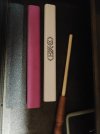- Joined
- Feb 7, 2015
- Messages
- 20
I've noticed that there is a fairly diverse list of how people sharpen their khukuri. From what I can see the best method may be using sharpening rods as they will fit in the curve of the recurve. That being said I am not sure what products work well or where to purchase them.
What tools are you using and where do you prefer to get them?
What tools are you using and where do you prefer to get them?



